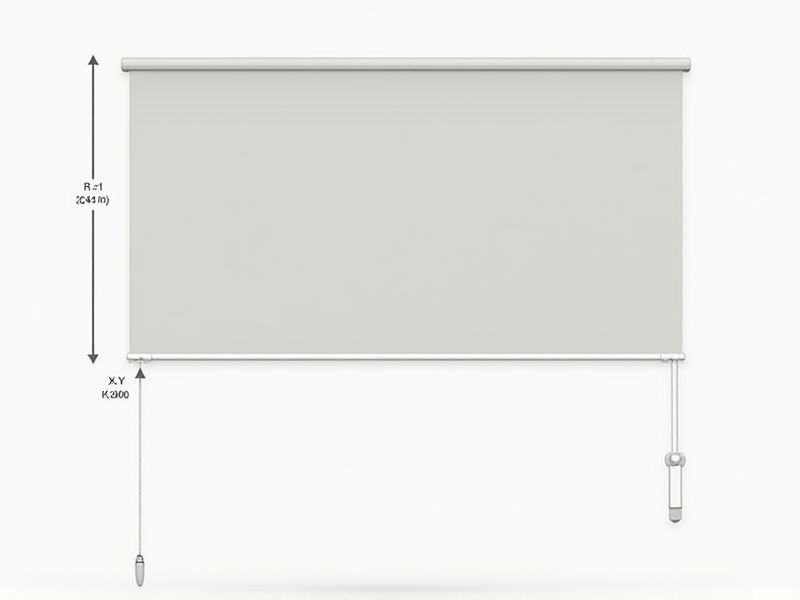
Standard dimensions for roller blinds typically range in width from 24 inches (about 60 cm) to 72 inches (about 183 cm), and in length from 36 inches (about 91 cm) to 84 inches (about 213 cm). These sizes are designed to fit most common window frames in homes and offices. When selecting a roller blind, it's important to measure your window accurately to ensure proper coverage and functionality. Many retailers also offer custom sizing options, allowing you to get a perfect fit even for unusually sized windows.
Width Options
Roller blinds typically come in a variety of width options to cater to different window sizes and personal preferences. Common standard widths include 24, 30, 36, 48, 60, and 72 inches, allowing you to find the perfect fit for your space. Custom options are also available, enabling widths as narrow as 18 inches or as wide as 100 inches, depending on the manufacturer. Selecting the right width ensures optimal light control and energy efficiency, enhancing your room's comfort and aesthetics.
Height Options
When selecting roller blinds, height options are crucial for achieving the perfect fit. Common height selections range from 48 inches to 96 inches, accommodating various window sizes and configurations. Custom heights are also available, allowing you to specify dimensions to match your interior decor precisely. By measuring your window accurately, you can enhance both functionality and aesthetic appeal in your living spaces.
Fabric Thickness
The standard for roller blind fabric thickness typically ranges from 0.25 mm to 0.5 mm, which affects both light filtration and durability. Thicker fabrics, around 0.5 mm, offer enhanced insulation and UV protection, making them ideal for areas with intense sunlight exposure. Conversely, thinner options, approximately 0.25 mm, provide a more sheer appearance, allowing natural light to filter through while maintaining privacy. When selecting roller blinds, consider how the fabric thickness aligns with your specific needs for light control and energy efficiency.
Cassette Size
The standard cassette size for roller blinds typically ranges from 3 to 4 inches in diameter, ensuring a sleek and unobtrusive appearance when installed. This compact design not only provides aesthetic appeal but also allows for efficient space management, particularly in smaller windows. Your choice of cassette size can influence the overall look and functionality of the blinds, with larger cassettes often accommodating thicker fabrics for enhanced light control and privacy. Regular maintenance of the cassette mechanism, including lubricating moving parts, will ensure longevity and smooth operation.
Roller Tube Diameter
The roller tube diameter of a roller blind is a crucial factor influencing both its functionality and appearance, typically ranging from 25 mm to 89 mm for residential applications. A larger diameter often provides better support for heavier fabrics and allows for easier operation, enhancing durability and longevity. Standard fittings for these tubes are designed to accommodate a range of mounting options, ensuring compatibility with various window sizes and styles. When selecting roller blinds, consider your window dimensions and aesthetic preferences to choose the optimal tube diameter for your needs.
Bracket Size
The standard roller blind bracket size typically varies between 1.5 inches to 2 inches, ensuring compatibility with most window frames. For optimal functionality, select a bracket that can support a weight capacity of at least 5 pounds, accommodating various fabric styles and materials. You should consider the installation depth, which ranges from 1 inch to 3 inches, to ensure a flush mount against the wall or ceiling. Proper bracket sizing not only affects installation ease but also enhances the roller blind's overall durability and performance.
Chain Length
The standard chain length for roller blinds typically ranges from 90 to 120 centimeters, ensuring optimal functionality and ease of operation. A shorter chain may limit accessibility, while a longer one can prevent tangling but may pose a safety risk, especially in homes with small children or pets. It's crucial to select a chain length that balances convenience and safety, conforming to industry guidelines. You should consider the mounting height and window size when determining the most suitable chain length for your roller blinds.
Hem Bar Type
The hem bar type roller blind typically features a weighted bottom bar that enhances stability and maintains the fabric's tension, preventing sagging. Measuring around 25-35mm in width, these hem bars are often made from durable materials like aluminum or steel, providing both strength and longevity. This design not only contributes to a clean, finished appearance but also allows for smooth and effortless operation, accommodating various window sizes and types. When selecting your roller blind, consider the hem bar option for added functionality and aesthetic appeal in your space.
Headrail Dimensions
The headrail dimensions of roller blinds typically range from 25mm to 40mm in width, with a standard length aligning with the width of the window. This component serves as the backbone of the roller blind system, ensuring stability and ease of operation. A properly measured headrail can significantly enhance the blinds' aesthetic appeal, as well as functionality, with fit tolerances often set at +-2mm for optimal performance. For your installation needs, verifying the precise headrail size will ensure a seamless integration with your home decor.
Mounting Space Requirements
Mounting space for roller blinds typically requires a minimum depth of 3 to 4 inches for proper installation, ensuring the blind operates smoothly. It's crucial to measure accurately, as insufficient space can lead to operational issues or aesthetic shortcomings. You should also consider the width of the window; blinds should overlap the window frame by at least 1 to 2 inches on each side for optimal light control and privacy. Furthermore, the choice of mounting type--inside or outside--will significantly affect the required space, with inside mounts needing precise measurements for a clean fit.
